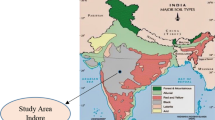Abstract
Probabilistic seismic hazard analysis (PSHA) has been carried out for the district of Pathankot. The earthquake data has been collected from different seismological agencies, e.g. NDMA, IMD, ISC-UK and USGS, and a comprehensive earthquake catalogue has been developed. Several ground motion prediction equations have been reviewed to select a GMPE appropriate for carrying out PSHA. Earthquake hazard parameters have been estimated in terms of peak ground acceleration and spectral acceleration. The seismic hazard maps of the district have been prepared at various return periods at different probabilities of exceedance. The results show that the district can experience strong ground motions originating from earthquakes originating in north-west Himalayas. Therefore, structures must be designed using the hazard parameters determined considering the local tectonic setup of the region. The developed hazard maps would help engineers and architects involved in planning and design of earthquake-resistant structures and retrofitting works.
Access this chapter
Tax calculation will be finalised at checkout
Purchases are for personal use only
Similar content being viewed by others
References
Peltzer G, Saucier F (1996) Present day kinematics of Asia derived from geological fault rates. J Geophys Res 101:27943–27956
IS 1893—Part 1 (2002) Indian standard criteria for earthquake resistant design of structures, Part 1: General provisions and building. Bureau of Indian Standards, New Delhi
Puri N, Jain A (2016) Deterministic seismic hazard analysis for the state of Haryana, India. Indian Geotech J 46(2):164–174
Puri N, Jain A (2018) Possible seismic hazards in Chandigarh City of North-western India due to its proximity to Himalayan frontal thrust. J Ind Geophys Union 22(5):485–506
Dasgupta S et al (2000) Seismotectonic atlas of India and its environs. Geological Survey of India, Calcutta
Scordilis EM (2006) Empirical global relations converting Ms and mb to moment magnitude. J Seismol 10:225–236
Kolathayar S, et al (2012) Spatial variation of seismicity parameters across India and adjoining areas. Nat Hazards 60:1365–1379
Yenier E et al (2008) Empirical relationships for magnitude and source-to-site distance conversions using recently compiled Turkish strong-ground motion database. In: Proceedings of 14th world conference on earthquake engineering, Bei**g, China
Gupta ID (2002) The state of the art in seismic hazard analysis. ISET J Earthq Technol 39(4):311–346
Abrahamson NA et al (2013) Update of the AS08 ground-motion prediction equations based on the NGA-West2 data set. PEER Report 2013/04 Pacific Earthquake Engineering Research Center Headquarters, University of California, Berkeley
Eurocode 8: BS-EN 1998-1 (2005) Design of structures for earthquake resistance—part 1: General rules, seismic actions and rules for buildings. European Committee for Standardization, Brussels
Ordaz M, Salgado-Gálvez MA (2017) R-CRISIS validation and verification document. Technical Report, Mexico city, Mexico. NDMA (2014) Mw = 8.0 Mandi Earthquake Scenario: Multi-State Exercise and Awareness Campaign. National Disaster Management Authority, Government of India
Author information
Authors and Affiliations
Editor information
Editors and Affiliations
Rights and permissions
Copyright information
© 2020 Springer Nature Singapore Pte Ltd.
About this paper
Cite this paper
Puri, S.O., Puri, N., Naval, S., Jain, A. (2020). Probabilistic Seismic Hazards Maps for District of Pathankot (Punjab). In: Ahmed, S., Abbas, S., Zia, H. (eds) Smart Cities—Opportunities and Challenges. Lecture Notes in Civil Engineering, vol 58. Springer, Singapore. https://doi.org/10.1007/978-981-15-2545-2_38
Download citation
DOI: https://doi.org/10.1007/978-981-15-2545-2_38
Published:
Publisher Name: Springer, Singapore
Print ISBN: 978-981-15-2544-5
Online ISBN: 978-981-15-2545-2
eBook Packages: EngineeringEngineering (R0)




